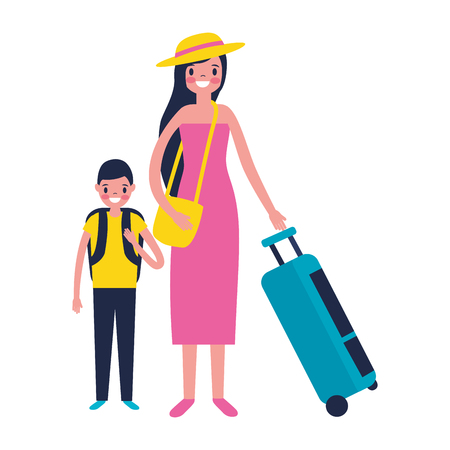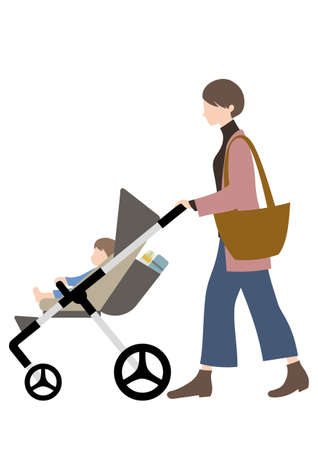Understanding UK Car Seat Laws
When it comes to travelling safely with babies and toddlers in the UK, understanding car seat laws is essential for every family. The UK has clear regulations designed to protect young children on the road, and compliance is not only a legal obligation but also a critical component of road safety. According to current UK legislation, all children must use an appropriate child car seat until they reach 12 years of age or 135 cm in height, whichever comes first. The choice of car seat depends on your childs height or weight, as outlined by the manufacturer’s guidelines, and it is crucial to select a model that meets the British or European safety standards (look for the ECE R44/04 or R129 i-Size mark).
For infants and toddlers, rear-facing seats are recommended for as long as possible due to their superior protection in the event of a collision. Once your child outgrows the rear-facing seat, a forward-facing seat with a harness is required until they reach the next stage. It is illegal—and highly unsafe—for a child to travel without an appropriate restraint, and penalties for non-compliance can include fines of up to £500. Furthermore, improper use or incorrect installation can compromise the effectiveness of even the best-rated car seats.
Staying informed about these regulations not only helps you avoid legal trouble but ensures your little ones are afforded the highest standard of safety while travelling on UK roads.
Choosing the Right Car Seat for Your Child
Selecting the correct car seat is fundamental to ensuring your baby or toddler’s safety on the road. In the UK, car seat regulations are governed by strict British and European standards to protect children during travel. The most relevant frameworks are i-Size (R129) and ECE R44/04, which specify requirements based on age, weight, and height. Understanding these standards will help you make an informed choice suited to your child’s needs.
Understanding Car Seat Categories
Car seats in the UK are classified according to either the child’s weight (ECE R44/04) or height (i-Size). Familiarise yourself with the following table to identify the appropriate type:
| Standard | Group/Category | Child’s Weight or Height | Approximate Age |
|---|---|---|---|
| ECE R44/04 | Group 0+ | Up to 13kg | Birth to 12–15 months |
| ECE R44/04 | Group 1 | 9–18kg | 9 months to 4 years |
| ECE R44/04 | Group 2/3 | 15–36kg | 4–12 years |
| i-Size (R129) | – | 40–105cm (height-based) | Birth to approximately 4 years |
The Importance of i-Size (R129) Compliance
The i-Size regulation prioritises a child’s height rather than weight, promoting rear-facing travel for longer and enhanced side-impact protection. For maximum safety, choose an i-Size compliant seat whenever possible, as these must pass more rigorous crash tests and fit most modern vehicles equipped with ISOFIX anchor points.
Key Points When Selecting a Car Seat:
- Check the label: Look for ECE R44/04 or i-Size (R129) approval marks to ensure the seat meets legal safety standards.
- Select based on your child’s current measurements: Do not move up a group until your child exceeds the recommended limits for their current seat.
- Pilot fit in your car: Not all seats fit every vehicle model. Test installation before purchasing, especially if using a seatbelt rather than ISOFIX.
- Avoid second-hand seats: Older or previously used seats may not comply with current regulations or could have hidden damage.
- Rear-facing is safest for young children: Keep infants rear-facing for as long as possible, ideally until at least 15 months old under i-Size rules.
Your Next Steps
If you are unsure about compatibility or installation, consult with a local retailer offering fitting services or check guidance from trusted organisations such as RoSPA or the Child Car Seats website run by GOV.UK. By carefully matching your child’s size and needs with an approved car seat, you lay a strong foundation for safe journeys throughout childhood.

3. Correct Installation and Positioning
Ensuring your child’s car seat is properly installed is crucial for their safety during every journey. In the UK, best practices begin with checking your vehicle’s compatibility with both ISOFIX and seat belt-fitted car seats. ISOFIX systems are highly recommended as they offer a secure and straightforward way to anchor the seat directly to the car’s chassis, reducing the risk of incorrect installation. Always consult both your vehicle’s manual and the car seat manufacturer’s instructions before fitting.
Harness Adjustments: Getting it Right
The harness should sit snugly against your child’s body, without slack. For infants, ensure the harness is at or just below shoulder level; for older toddlers in forward-facing seats, it should be at or just above their shoulders. The ‘pinch test’—where you try to pinch the harness strap at your child’s collarbone—can help; if you can gather any material, it needs tightening.
Rear-Facing versus Forward-Facing
The safest option for young children is to keep them rear-facing for as long as possible, ideally until at least 15 months old, or even longer if your seat allows. Rear-facing seats provide better protection for a baby’s head, neck, and spine in a collision. Only transition to forward-facing once your child exceeds the maximum height or weight limit specified by the car seat manufacturer.
Final Checks Before Every Trip
Before setting off, double-check that the seat is firmly attached (with no excessive movement), harnesses are correctly adjusted, and nothing obstructs the car seat path. These simple steps are essential in keeping your little one safe on Britain’s roads.
4. Common Mistakes to Avoid
Ensuring your child’s safety on the road is every parent’s priority, yet several frequent mistakes can put babies and toddlers at risk during car journeys. Below, we highlight the most common errors UK parents make with car seats, along with practical advice on how to prevent them.
Loose Harness Straps
A harness that is too loose may fail to restrain your child properly in the event of a sudden stop or collision. Always perform the pinch test—if you can pinch any webbing between your fingers at the child’s shoulder, the harness is too loose. The straps should lie flat and snug against your child’s chest without causing discomfort.
Bulky Clothing and Accessories
Dressing children in bulky coats or snowsuits before strapping them into their car seat is a common mistake that reduces harness effectiveness. Thick clothing compresses in a crash, leaving dangerous slack. Instead, dress your child in thin layers and cover them with a blanket over the harness for warmth once they are securely strapped in.
Incorrect Seat Angles
Infant carriers and convertible car seats must be installed at the correct recline angle to protect your child’s airway and reduce injury risk. A seat that is too upright can cause a baby’s head to flop forward, while one that is too reclined may reduce protection in a collision. Most UK car seats feature an angle indicator—always check this when installing or adjusting your seat.
Poor Installation Practices
Improper installation remains a significant safety concern. According to UK road safety data, as many as half of all car seats are incorrectly fitted. Common errors include failing to use the ISOFIX system correctly or not securing the seat belt tightly enough. Follow manufacturer instructions carefully and seek professional fitting assistance if needed.
Summary Table: Frequent Car Seat Mistakes and Solutions
| Mistake | Potential Risk | How to Prevent |
|---|---|---|
| Loose straps | Poor restraint in crash | Use ‘pinch test’ for snugness |
| Bulky clothing | Harness slack, ineffective protection | Dress in thin layers; add blanket after strapping in |
| Incorrect seat angle | Airway obstruction or reduced crash protection | Check seat’s angle indicator before travel |
| Poor installation | Seat movement or detachment during accident | Follow manual; get professional fitting if unsure |
Avoiding these common pitfalls will help ensure every journey is as safe as possible for your little one, offering peace of mind for families travelling across the UK.
5. Keeping Journeys Comfortable and Safe
When embarking on longer car journeys with babies and toddlers in the UK, preparation is key to ensuring both comfort and safety. Thoughtful planning can help prevent distress, reduce travel sickness, and manage any weather-related challenges that may arise. Here are some practical tips for UK families:
Plan Regular Breaks
For extended trips, schedule frequent stops—ideally every 1.5 to 2 hours—to give your child a chance to stretch, have a nappy change, or simply get some fresh air. Many UK service stations offer family-friendly facilities, making these breaks easier to manage.
Pack Essentials for Comfort
Ensure you have everything your child might need within easy reach: snacks suitable for their age, water or milk bottles, favourite toys, comforters, spare clothes, and wipes. A well-packed bag can make all the difference if you encounter unexpected delays on British motorways or rural roads.
Monitor Temperature
The UK’s unpredictable weather means you should dress your child in layers that can be easily added or removed as needed. Avoid bulky coats in the car seat as these can interfere with harness safety; instead, place a blanket over the harness if your child feels cold.
Minimise Travel Sickness
If your little one is prone to motion sickness—a common issue on winding British roads—try to travel during their nap times when possible. Keep the car well-ventilated, offer small sips of water, and avoid heavy meals right before departure. If necessary, consult your GP about suitable remedies for young children.
Entertainment and Distraction
Bring along soft toys, age-appropriate books, or preloaded audiobooks to keep your child entertained. Singing familiar nursery rhymes together can also provide comfort and distraction during long stretches of travel.
Stay Alert to Your Child’s Needs
Finally, always listen for signs of discomfort or distress. If your baby or toddler becomes unsettled despite your best efforts, it’s safer to pull over at a safe spot and attend to their needs rather than trying to soothe them while driving. These simple but effective strategies help ensure every family journey across the UK is both safe and enjoyable for even the youngest passengers.
6. Aftermarket Accessories: What’s Safe and What’s Not
When travelling with babies and toddlers, many UK parents are tempted to purchase aftermarket car seat accessories in hopes of making journeys more comfortable or convenient. However, not all add-ons available on the market comply with safety regulations, and some may even pose additional risks.
Understanding Approved Accessories
The most crucial point for families to remember is that only accessories supplied or approved by your car seat manufacturer are considered safe. This includes items such as seat protectors, head supports, and infant inserts designed specifically for your model. These have been crash-tested alongside the car seat, ensuring they do not interfere with its protective features.
Common Aftermarket Add-ons in the UK
Popular aftermarket products include harness covers, additional padding, sunshades, cup holders, and travel tray tables. While these may seem harmless or helpful for longer trips, their use can sometimes compromise the integrity of the car seat system or affect how securely your child is restrained.
Which Products to Avoid
Items such as thick padded harness covers, extra headrests, or non-manufacturer inserts can alter how the harness fits and performs during a collision. Similarly, generic seat protectors placed underneath a car seat may reduce friction between the seat and vehicle upholstery, increasing movement in an impact. Even mirror attachments designed for rear-facing seats must be fitted securely and never distract the driver.
Regulatory Guidance in the UK
The Royal Society for the Prevention of Accidents (RoSPA) and Child Car Seats UK both advise against using any accessory that was not provided with or explicitly recommended by your car seat manufacturer. Using unapproved accessories can void warranties and insurance claims should an accident occur.
Safe Choices for Peace of Mind
If you feel your child needs additional comfort or support, always check your car seat manual first. Most major brands offer approved add-ons to address common concerns without sacrificing safety. When in doubt, consult with a qualified child passenger safety advisor or visit a local fitting station for guidance.
Ultimately, simplicity is best: use your car seat exactly as intended by its manufacturer. Avoiding untested aftermarket additions ensures you provide the safest possible environment for your little one every time you travel on UK roads.
7. Emergency Preparedness on the Road
When travelling with babies and toddlers, being prepared for unexpected situations is essential to ensure everyone’s safety and wellbeing. UK roads can be unpredictable, whether you’re navigating busy motorways or rural lanes. Every family should have an emergency plan in place before setting off.
Checklist of Essentials for Emergencies
- Fully charged mobile phone with important contacts saved (including roadside assistance and your GP surgery).
- First aid kit tailored for children—include plasters, antiseptic wipes, child-safe pain relief (like paracetamol or ibuprofen), and any prescribed medication.
- Warm blankets or extra layers, especially during colder months.
- Bottled water and non-perishable snacks suitable for young children.
- Nappies, wipes, spare clothes, and plastic bags for soiled items.
- Reflective warning triangle and high-visibility vests for all passengers.
- Torch with spare batteries.
Child-Specific Considerations
- If you need to stop on the hard shoulder, keep babies and toddlers secured in their car seat until it is safe to move them to a safer location away from traffic.
- Know how to quickly remove your child from their car seat in case of an accident—practise releasing harnesses and buckles calmly.
- If using a rear-facing seat, familiarise yourself with emergency removal techniques that minimise movement of the head and neck, which is crucial after a collision.
What to Do in Case of a Breakdown or Accident
- If possible, move your vehicle to a safe spot away from traffic.
- Turn on hazard lights immediately.
- If it is safe to do so, exit the vehicle on the passenger side, taking children with you. Stand behind the barrier away from moving traffic.
- Never leave a child unattended in the car, even briefly.
Additional Tips for UK Families
Keep up-to-date with local weather and travel alerts before your journey. Make sure your breakdown cover includes home start and family recovery options. If you’re travelling long distances, share your travel plan with a friend or relative. By staying prepared and equipped, UK families can handle emergencies confidently while keeping little ones safe on every journey.


